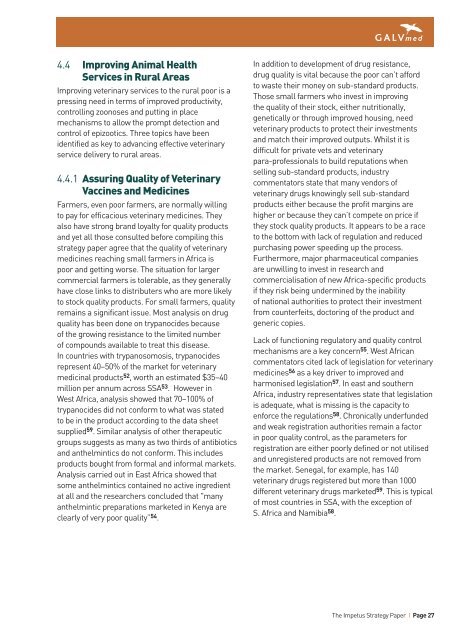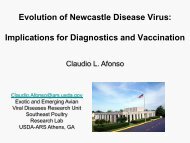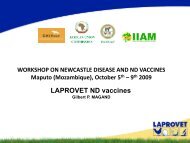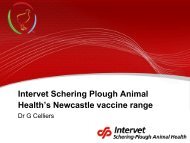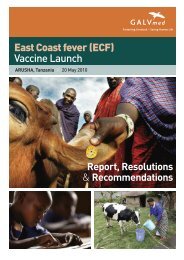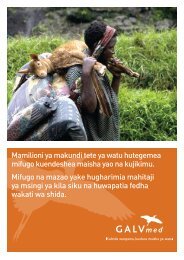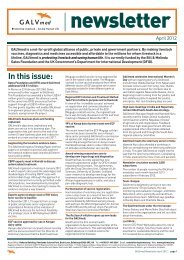A Path to Prosperity New Directions for African Livestock
GALVmed Impetus Strategy Paper
GALVmed Impetus Strategy Paper
- No tags were found...
Create successful ePaper yourself
Turn your PDF publications into a flip-book with our unique Google optimized e-Paper software.
4.4 Improving Animal Health<br />
Services in Rural Areas<br />
Improving veterinary services <strong>to</strong> the rural poor is a<br />
pressing need in terms of improved productivity,<br />
controlling zoonoses and putting in place<br />
mechanisms <strong>to</strong> allow the prompt detection and<br />
control of epizootics. Three <strong>to</strong>pics have been<br />
identified as key <strong>to</strong> advancing effective veterinary<br />
service delivery <strong>to</strong> rural areas.<br />
4.4.1 Assuring Quality of Veterinary<br />
Vaccines and Medicines<br />
Farmers, even poor farmers, are normally willing<br />
<strong>to</strong> pay <strong>for</strong> efficacious veterinary medicines. They<br />
also have strong brand loyalty <strong>for</strong> quality products<br />
and yet all those consulted be<strong>for</strong>e compiling this<br />
strategy paper agree that the quality of veterinary<br />
medicines reaching small farmers in Africa is<br />
poor and getting worse. The situation <strong>for</strong> larger<br />
commercial farmers is <strong>to</strong>lerable, as they generally<br />
have close links <strong>to</strong> distributers who are more likely<br />
<strong>to</strong> s<strong>to</strong>ck quality products. For small farmers, quality<br />
remains a significant issue. Most analysis on drug<br />
quality has been done on trypanocides because<br />
of the growing resistance <strong>to</strong> the limited number<br />
of compounds available <strong>to</strong> treat this disease.<br />
In countries with trypanosomosis, trypanocides<br />
represent 40–50% of the market <strong>for</strong> veterinary<br />
medicinal products 52 , worth an estimated $35–40<br />
million per annum across SSA 53 . However in<br />
West Africa, analysis showed that 70–100% of<br />
trypanocides did not con<strong>for</strong>m <strong>to</strong> what was stated<br />
<strong>to</strong> be in the product according <strong>to</strong> the data sheet<br />
supplied 59 . Similar analysis of other therapeutic<br />
groups suggests as many as two thirds of antibiotics<br />
and anthelmintics do not con<strong>for</strong>m. This includes<br />
products bought from <strong>for</strong>mal and in<strong>for</strong>mal markets.<br />
Analysis carried out in East Africa showed that<br />
some anthelmintics contained no active ingredient<br />
at all and the researchers concluded that "many<br />
anthelmintic preparations marketed in Kenya are<br />
clearly of very poor quality” 54 .<br />
In addition <strong>to</strong> development of drug resistance,<br />
drug quality is vital because the poor can’t af<strong>for</strong>d<br />
<strong>to</strong> waste their money on sub-standard products.<br />
Those small farmers who invest in improving<br />
the quality of their s<strong>to</strong>ck, either nutritionally,<br />
genetically or through improved housing, need<br />
veterinary products <strong>to</strong> protect their investments<br />
and match their improved outputs. Whilst it is<br />
difficult <strong>for</strong> private vets and veterinary<br />
para-professionals <strong>to</strong> build reputations when<br />
selling sub-standard products, industry<br />
commenta<strong>to</strong>rs state that many vendors of<br />
veterinary drugs knowingly sell sub-standard<br />
products either because the profit margins are<br />
higher or because they can’t compete on price if<br />
they s<strong>to</strong>ck quality products. It appears <strong>to</strong> be a race<br />
<strong>to</strong> the bot<strong>to</strong>m with lack of regulation and reduced<br />
purchasing power speeding up the process.<br />
Furthermore, major pharmaceutical companies<br />
are unwilling <strong>to</strong> invest in research and<br />
commercialisation of new Africa-specific products<br />
if they risk being undermined by the inability<br />
of national authorities <strong>to</strong> protect their investment<br />
from counterfeits, doc<strong>to</strong>ring of the product and<br />
generic copies.<br />
Lack of functioning regula<strong>to</strong>ry and quality control<br />
mechanisms are a key concern 55 . West <strong>African</strong><br />
commenta<strong>to</strong>rs cited lack of legislation <strong>for</strong> veterinary<br />
medicines 56 as a key driver <strong>to</strong> improved and<br />
harmonised legislation 57 . In east and southern<br />
Africa, industry representatives state that legislation<br />
is adequate, what is missing is the capacity <strong>to</strong><br />
en<strong>for</strong>ce the regulations 58 . Chronically underfunded<br />
and weak registration authorities remain a fac<strong>to</strong>r<br />
in poor quality control, as the parameters <strong>for</strong><br />
registration are either poorly defined or not utilised<br />
and unregistered products are not removed from<br />
the market. Senegal, <strong>for</strong> example, has 140<br />
veterinary drugs registered but more than 1000<br />
different veterinary drugs marketed 59 . This is typical<br />
of most countries in SSA, with the exception of<br />
S. Africa and Namibia 58 .<br />
The Impetus Strategy Paper I Page 27


